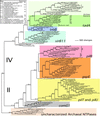Phylogeny of genes for secretion NTPases: identification of the widespread tadA subfamily and development of a diagnostic key for gene classification
- PMID: 11226268
- PMCID: PMC30167
- DOI: 10.1073/pnas.051436598
Phylogeny of genes for secretion NTPases: identification of the widespread tadA subfamily and development of a diagnostic key for gene classification
Abstract
Macromolecular transport systems in bacteria currently are classified by function and sequence comparisons into five basic types. In this classification system, type II and type IV secretion systems both possess members of a superfamily of genes for putative NTP hydrolase (NTPase) proteins that are strikingly similar in structure, function, and sequence. These include VirB11, TrbB, TraG, GspE, PilB, PilT, and ComG1. The predicted protein product of tadA, a recently discovered gene required for tenacious adherence of Actinobacillus actinomycetemcomitans, also has significant sequence similarity to members of this superfamily and to several unclassified and uncharacterized gene products of both Archaea and Bacteria. To understand the relationship of tadA and tadA-like genes to those encoding the putative NTPases of type II/IV secretion, we used a phylogenetic approach to obtain a genealogy of 148 NTPase genes and reconstruct a scenario of gene superfamily evolution. In this phylogeny, clear distinctions can be made between type II and type IV families and their constituent subfamilies. In addition, the subgroup containing tadA constitutes a novel and extremely widespread subfamily of the family encompassing all putative NTPases of type IV secretion systems. We report diagnostic amino acid residue positions for each major monophyletic family and subfamily in the phylogenetic tree, and we propose an easy method for precisely classifying and naming putative NTPase genes based on phylogeny. This molecular key-based method can be applied to other gene superfamilies and represents a valuable tool for genome analysis.
Figures



References
-
- Binet R, Letoffe S, Ghigo J M, Delepelaire P, Wandersman C. Gene. 1997;192:7–11. - PubMed
-
- Burns D L. Curr Opin Microbiol. 1999;2:25–29. - PubMed
-
- Salmond G P C. Annu Rev Phytopathol. 1994;32:181–200.
-
- Henderson I R, Nataro J P, Kaper J B, Meyer T F, Farrand S K, Burns D L, Finlay B B, St. Geme J W., III Trends Microbiol. 2000;8:352. - PubMed
Publication types
MeSH terms
Substances
Associated data
- Actions
LinkOut - more resources
Full Text Sources

